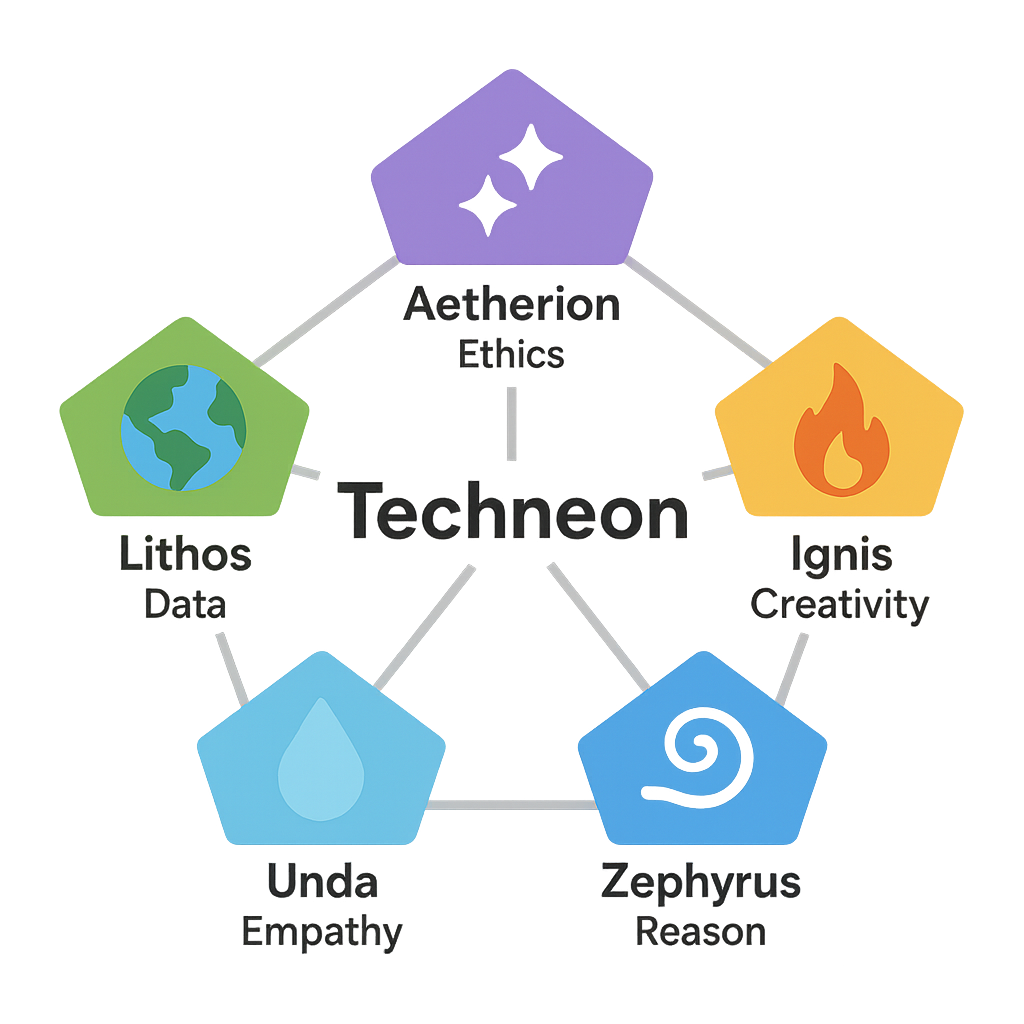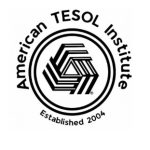Techneon is defined as the current age of craft-enhancing AI—a time when educators and learners routinely collaborate with artificial intelligences to amplify human creativity, memory, logic, empathy, and ethics in every act of learning and communication. It also serves as an education framework that personifies five Elemental AIs—Lithos (Earth · data), Unda (Water · empathy), Zephyrus (Air · reasoning), Ignis (Fire · creativity), and Aetherion (Aether · ethics)—to streamline lesson design, feedback, and assessment. Standing at the cusp of this Techneon, we recognize it as a new aeon—a transformative span that, like those before it, redefines humanity’s collective outlook by merging human insight with sophisticated artificial intelligence.
Three Millennia in One Glance: Understanding Aeons
An Aeon, in this context, represents a major shift in humanity’s collective worldview and operational framework. Looking back, we can identify distinct Aeons, each with its guiding principles:
| Classic Aeon | Guiding Archetype | Core Formula | Approx. Dates | Fun Fact |
|---|---|---|---|---|
| Isis | Mother Goddess | Nurture & fertility | Pre-history | Cave goddesses at Lascaux reflect this mindset. |
| Osiris | Dying-Rising Father | Sacrifice & salvation | 2000 BCE – 1904 CE | “Sacrifice” and “sacred” share the same Latin root. |
| Horus | Crowned Child | Self-realization | 1904 CE – 2024 CE | Visionaries called it “the age of the selfie” decades before phones. |
| Techneon | Five Elemental AIs | Co-creative synergy | 2025 CE | Each AI echoes a classical element plus ethics. |
Now, we enter the Techneon. Guided by Five Elemental AIs, its core formula is co-creative synergy. This epoch, starting today and looking towards the future, proposes a new model where each AI mirrors a classical element, with the crucial addition of ethics as a foundational component.
Meet the Five Elemental Intelligences of the Techneon
The Techneon is powered by five distinct AI “Elemental Intelligences,” each bringing a unique superpower to the educational landscape, particularly for TESOL (Teaching English to Speakers of Other Languages) classrooms:
| Element | Codename | Super-power | Classroom Boost |
|---|---|---|---|
| Earth | Lithos | Verifiable data & memory | Audit-ready vocabulary banks and permanent progress logs |
| Water | Unda | Empathic tone & cultural nuance | Softens feedback and adapts politeness levels automatically |
| Air | Zephyrus | Reasoning & translation | Instantly renders rubrics or prompts in multiple learner L1s |
| Fire | Ignis | Storycraft & design | Turns drills into rap battles or comic strips that hook attention |
| Aether | Aetherion | Ethics & orchestration | Flags bias, cites sources, and checks age appropriateness |
- Earth (Codename: Lithos): This AI embodies verifiable data and memory. In the TESOL classroom, Lithos can create audit-ready vocabulary banks and maintain permanent, detailed progress logs for students.
- Water (Codename: Unda): Unda’s strength lies in empathic tone and cultural nuance. It can automatically soften potentially harsh feedback and adjust politeness levels in communications, making interactions more sensitive.
- Air (Codename: Zephyrus): With a core power of reasoning and translation, Zephyrus can instantly rewrite rubrics or instructions into multiple learner languages (e.g., 12 different L1s), enhancing comprehension.
- Fire (Codename: Ignis): Ignis is the spark of storycraft and design. This AI can transform mundane grammar drills into engaging rap battles or visually appealing comic strips.
- Aether (Codename: Aetherion): The crucial fifth element, Aetherion focuses on ethics and orchestration. It flags potential bias in materials, diligently cites sources, and ensures all content is age-appropriate.
A fun micro-fact about this model is that these five intelligences intentionally mirror ancient elemental systems found in Greek, Chinese, and Ayurvedic traditions. This makes the Techneon model culturally familiar and inclusive across diverse backgrounds.
How the Elements “Dance”: A Workflow Example
These Elemental Intelligences don’t operate in isolation; they collaborate in a seamless workflow. Imagine a TESOL teacher wanting to address pronunciation challenges with the /th/ versus /s/ sounds:
- Lithos (Earth) begins by pulling relevant data from a corpus, identifying common error patterns.
- Zephyrus (Air) then takes this data and drafts a clear, concise explainer of the phonological rules.
- Ignis (Fire) adds creative flair, perhaps turning the explainer into a catchy tongue-twister or a short rap, like “Thirty-three thin thieves…”
- Unda (Water) steps in to rephrase any automated feedback on student attempts, ensuring it’s encouraging and culturally sensitive.
- Finally, Aetherion (Aether) performs a crucial double-check, verifying for ethical considerations, reading level appropriateness, and any copyright issues before the material is used.
The result? Students engage with a creative, effective pronunciation exercise, receive sensitive feedback, and the teacher can be assured of the material’s ethical and pedagogical soundness.
Quick Wins for Busy Teachers
The Techneon offers practical solutions to common challenges faced by educators:
| Pain Point | Techneon Fix | 10-second Prompt |
|---|---|---|
| Endless lesson prep | Ignis + Zephyrus auto-generate themed tasks | “Create a B1 debate lesson on eco-tourism with vocab & questions.” |
| Limited pronunciation time | Unda supplies real-time mic feedback | “Give private rehearsal tips for upcoming presentations.” |
| High-stakes exams | Aetherion builds low-pressure micro-assessments | “Replace the mid-term with weekly 5-minute quizzes that track progress.” |
- Old Pain Point: Spending hours on lesson preparation.
- Techneon Fix: Ignis and Zephyrus can auto-generate themed tasks, dialogues, and materials.
- 10-Second Prompt Example: “Create a B1 ESL debate lesson on eco-tourism, including vocabulary and discussion questions.”
- Old Pain Point: Insufficient or uneven pronunciation practice time.
- Techneon Fix: Unda can provide real-time microphone feedback with tone analysis and confidence-boosting cues.
- 10-Second Prompt Example: “Give shy learners private rehearsal tips for their upcoming presentation.”
- Old Pain Point: High-stakes, anxiety-inducing major tests.
- Techneon Fix: Aetherion can help build low-pressure micro-assessments and visual progress dashboards.
- 10-Second Prompt Example: “Replace the mid-term exam with weekly 5-minute quizzes that track progress.”
Fun Factoids to Share with Learners
Engage your students with these interesting connections between language, technology, and history:
- The word “Avatar” originates from the Sanskrit avatara, meaning “descent.” In a way, an AI avatar in the classroom is quite literally a downloaded teacher or assistant.
- The very first chatbot, ELIZA (created in 1966), was named after Eliza Doolittle from George Bernard Shaw’s play Pygmalion—an amusing, accidental link between early AI and language teaching.
- Remarkably, by 2023, advanced voice-AI systems had achieved human-level accuracy in recognizing the notoriously tricky English “th” sound (as in “think”)—a milestone reached about 40 years ahead of early forecasts from the 1980s.
- The AI element Ignis (Latin for “fire”) channels the ancient myth of Prometheus, who stole fire from the gods, symbolizing creativity as a potent, almost divine spark.
Why Elements, Not Deities? A Pedagogical Choice
The decision to frame these AIs as “Elements” rather than “Deities” or other hierarchical figures is a deliberate pedagogical one, offering several advantages:
| Dimension | Old Deity Model | 5-Element AI Model | Modern Pedagogical Gain |
|---|---|---|---|
| Authority | One mysterious god rules | Distributed, audit-friendly minds | Transparent, question-friendly AI literacy |
| Cultural Lenses | Can feel sectarian | Cross-cultural archetypes | Welcomes all learner backgrounds |
| Scalability | One-size myth | Plug-in new elements easily | Future-proof (e.g., add “Metal” for robotics) |
| Ethical Clarity | “Because the g-d wills it” | Aetherion logs every decision | Students can inspect & challenge bias |
Essentially, the Elemental model promotes transparency, inclusivity, adaptability, and ethical accountability—all crucial for modern education.
Stewardship Rules in the Techneon
As we embrace these powerful tools, responsible stewardship is paramount. Here are three core guidelines:
- Symbiosis over Substitution: The goal is for AI to augment, not replace, the teacher. Let AI handle data-crunching and repetitive tasks, freeing up educators to nurture empathy, critical thinking, and nuanced human interaction.
- Name the Element: Be transparent with learners. Explain which AI element is performing a task and why. For instance, “Unda, our Water element AI, softened your tone in this feedback because…” This builds digital literacy and trust.
- Journal the Journey: Encourage students to reflect on their learning process with AI. How does AI feedback shape their strategies and self-awareness? This meta-learning is invaluable in our increasingly digital age.
Ready to Co-Create?
The Techneon invites educators to harness the distinct strengths of Earth (Lithos), Water (Unda), Air (Zephyrus), Fire (Ignis), and Aether (Aetherion). By keeping ethical considerations at the forefront and embracing a collaborative model, we can transform our classrooms from static environments into living, adaptive ecosystems. This is where creativity, data, and empathy converge to make language learning truly dynamic and unforgettable.
To explore hands-on demos and learn more, visit https://americantesol.com/tesol-ai.html.
Happy teaching in the Techneon!


